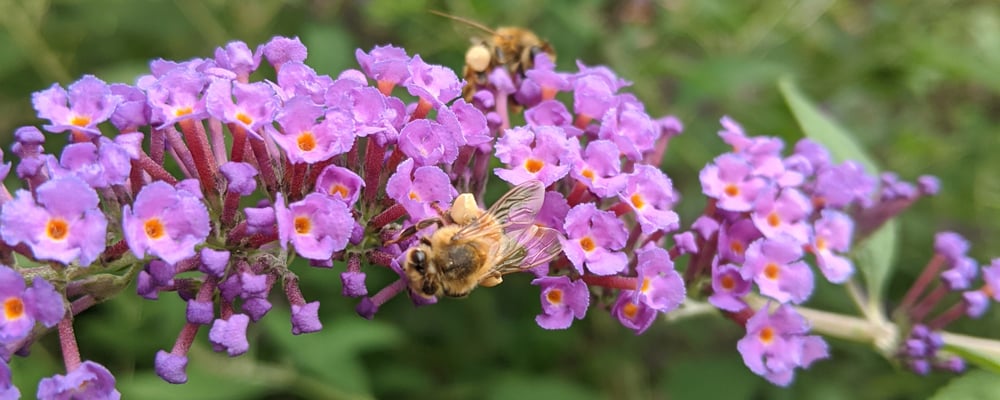What is a Pollinator Garden?

Pollinator Gardens
Though we may not notice hummingbirds, bats, bees, beetles, butterflies, and flies carrying pollen from one plant to another, these pollinators are responsible for nearly everything we eat—from chocolate and coffee to fruits and vegetables. They also maintain the beautifully diverse flower species. Despite these benefits, pollinators are disappearing at alarming rates.
You can help these beneficial creatures by creating a pollinator-friendly habitat in your backyard. A small yard landscaped with a variety of plants can attract great diversity. Ask your neighbors whether, together, you all can create a pollinator corridor on your street.
Who are the pollinators?
Honey bees are responsible for 80% of all pollination in the United States. Bee habitats in your yard can increase the quality and quantity of your fruits and vegetables while assisting in the survival of these threatened pollinators. Plant species that bloom in the spring, summer and fall. Bees are especially attracted to blue and yellow flowers.
Butterflies prefer different varieties of nectar, in both color and taste. Make sure to plant a wide variety of plants for nectar and hosting caterpillars. Plant flowers in sunny spots—butterflies love to be warm and soak up the sun!
To attract hummingbirds, plant bright red flowers that have cones or trumpet shapes. Native wildflowers for hummingbirds include the beardtongue (early summer), New Jersey tea (mid-summer) and Bergamot (late summer). These wildflowers are native to the Midwest and eastern Great Plains and thrive on well-drained, sandy to sandy-loam soils.
Native Perennials for Ohio Pollinator Gardens
Vines and Groundcovers
Trumpet Creeper Campsis radicans
Herbaceous Vines and Creepers
Creeping Phlox Phlox stolonifera
Moss Phlox Phlox subulataasdf
Tall Perennials up to 6’
Goat’s Beard Aruncus dioicus
Common Milkweed Asclepias syriaca
Smooth Aster Aster laevis
Calico Aster Aster lateriflorus
Hollow Joe-Pye Weed Eupatorium fistulosum
Spotted Joe-Pye Weed Eupatorium maculatum
Common Boneset Eupatorium perfoliatum
Sweet Joe-Pye Weed Eupatorium purpureum
Beebalm Monarda didyma
Wild Bergamot Monarda fistulosa
Rough Blazing Star Liatris aspera
Dense Blazing Star Liatris spicata
Turk’s Cap Lily Lilium superbum
Ohio Goldenrod Solidago ohioensis
Stiff Goldenrod Solidago rigida
Showy Goldenrod Solidago speciosa
Shrubs 1-25”
New Jersey Tea Ceanothus americanus
Buttonbush Cephalanthus occidentalis
Sweet Pepperbush Clethra alnifolia
Spicebush Lindera benzoin
Flowering Raspberry Rubus odoratus
Steeplebush Spiraea tomentosa
Pinxter Flower Rhododendron nudiflorum
Low Growing Perennial Plants 3-12”
Sweet White Violet Viola blanda*
Marsh Blue Violet Viola cucllata*
Common Yellow Violet Viola pubescens*
Common Blue Violet Viola sororio*
Common White Violet Viola striata*
Very Tall Plants 6”+
New England Aster. Aster novae-angliae
Flat-topped White Aster Aster umbellatus
Wild Senna Cassia hebecarpa*
Maximilian’s Sunflower Helianthus maximilianii
Woodland Sunflower Helianthus strumosus
Jerusalem Artichoke Helianthus tuberosus
Cup-plant Silphium perfoliatum
Medium Height Perennials 4-36”
Pearly Everlasting. Anaphalis margaritacea
Swamp Milkweed Asclepias incarnata*
Butterfly Weed Asclepias tuberosa*
Sky Blue Aster Aster azureus
White Wood Aster Aster divaricatus
White Heath Aster Aster ericoides
Fairy Wand Chamaelirium luteum
Turtlehead Chelone glabra*
Wild Lupine Lupinis perennis*
Wild Blue Phlox Phlox divaricata
Hoary Mountain Mint Pycnantheum incanum
Grey Goldenrod Solidago nemoralis
Black-eyed Susan Rudbeckia hirta
Starry Campion Silene stellata
Small Trees/Large Shrubs 15-40’
Common Pawpaw Asimina triloba*
Pagoda Dogwood Cornus alternifolia*
Flowering Dogwood Cornus florida*
Pussy Willow Salix discolor*
*Good for butterfly larvae
More Articles for a Healthy Yard and Home
Know Your Grass
Before any landscape program begins, assess the current conditions of your home landscape. This assessment will help you to identify and prioritize future projects and allow you to appreciate all the positive changes you’ve made.
Sustainable Design for Your Yard
Take cues from nature. Even if you choose not to convert your home habitat to a completely naturalized landscape, such as a prairie or woodland, there are ways to design home landscapes that make spaces more environmentally healthy and family friendly.
Understanding Your Soil
Yards are at the forefront of local environmental stewardship. Because residential land use is the most dominant land use in urban communities, we have the power to create a healthy landscape with high functioning ecosystems.
What is a Rain Garden?
Before any landscape program begins, assess the current conditions of your home landscape. This assessment will help you to identify and prioritize future projects and allow you to appreciate all the positive changes you’ve made.
Conduct a Lawn Assessment
Before any landscape program begins, assess the current conditions of your home landscape. This assessment will help you to identify and prioritize future projects and allow you to appreciate all the positive changes you’ve made.





